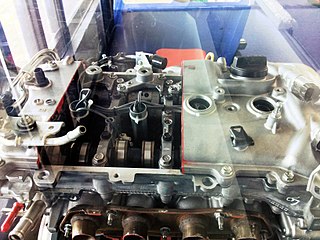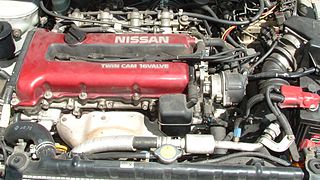
A camshaft is a shaft that contains a row of pointed cams in order to convert rotational motion to reciprocating motion. Camshafts are used in piston engines, mechanically controlled ignition systems and early electric motor speed controllers.

VTEC is a system developed by Honda to improve the volumetric efficiency of a four-stroke internal combustion engine, resulting in higher performance at high RPM, and lower fuel consumption at low RPM. The VTEC system uses two camshaft profiles and hydraulically selects between profiles. It was invented by Honda engineer Ikuo Kajitani. It is distinctly different from standard VVT systems which change only the valve timings and do not change the camshaft profile or valve lift in any way.

Variable valve timing (VVT) is the process of altering the timing of a valve lift event in an internal combustion engine, and is often used to improve performance, fuel economy or emissions. It is increasingly being used in combination with variable valve lift systems. There are many ways in which this can be achieved, ranging from mechanical devices to electro-hydraulic and camless systems. Increasingly strict emissions regulations are causing many automotive manufacturers to use VVT systems.

VVT-i, or Variable Valve Timing with intelligence, is an automobile variable valve timing petrol engine technology manufactured by Toyota Group and used by brands Groupe PSA, Toyota, Lexus, Scion, Daihatsu, Subaru, Aston Martin, Pontiac and Lotus Cars. It was introduced in 1995 with the 2JZ-GE engine found in the JZS155 Toyota Crown and Crown Majesta.

Nissan Ecology Oriented Variable Valve Lift and Timing is an automobile variable valve timing technology developed by Nissan. VVL varies the duration, and lift of valves by using hydraulic pressure switch between two different sets of camshaft lobes. VVT varies the valve timing throughout the RPM range. Together they function similarly to Honda's VTEC system.

The Ford Super High Output (SHO) V8 engine was designed and built by Ford Motor Company in conjunction with Yamaha Motor Corporation for use in the 1996 Ford Taurus SHO. It was based on the successful Ford Duratec engine rather than its predecessor, the compact Ford SHO V6 engine developed by Yamaha for the 1989 Taurus SHO. The engine was retired in 1999 when production of the third-generation Taurus SHO ended.

The RB engine is an oversquare 2.0–3.0 L straight-6 four-stroke gasoline engine from Nissan, originally produced from 1985 to 2004. The RB followed the 1983 VG-series V6 engines to offer a full, modern range in both straight or V layouts. It was part of a new engine family name PLASMA.

The VG engine is a family of V6 engines designed and produced by Nissan between 1983 and 2004.

The SR engine is a series of 1.6 L (1,596 cc), 1.8 L (1,838 cc) or 2.0 L (1,998 cc) straight-four, four-stroke gasoline engines manufactured by Nissan. It has an aluminium head and block with steel sleeves and has a DOHC 4-valve design, with variable valve timing on select models. It was added to a new engine family name PLASMA.

The GA engine is a 1.3 to 1.6 L inline-four piston engine from Nissan. It has a cast-iron block and an aluminum head. There are SOHC and DOHC versions, 8, 12, and 16 valve versions, carbureted, single-point, and multi-point injected versions, and versions with variable valve timing (GA16DE). The GA was produced from August 1987 through 2013. Since 1998, it was only available from Mexico in the B13.

The SR20DET is a 2.0 L (1,998 cc) straight-four four-stroke gasoline engine that is part of the SR family of engines from Nissan, produced from 1989 to 2002. It is a turbocharged version of the SR20DE engine and is a replacement of the CA18DET engine.

The Honda K-series engine is a line of four-cylinder four-stroke car engine introduced in 2001. The K-series engines are equipped with DOHC valvetrains and use roller rockers on the cylinder head to reduce friction. The engines use a coil-on-plug, distributorless ignition system with a coil for each spark plug. This system forgoes the use of a conventional distributor-based ignition timing system in favor of a computer-controlled system that allows the ECU to control ignition timings based on various sensor inputs. The cylinders have cast iron sleeves similar to the B- and F-series engines, as opposed to the FRM cylinders found in the H- and newer F-series engines found only in the Honda S2000.

The L-series is a compact inline-four engine created by Honda, introduced in 2001 with the Honda Fit. It has 1.2 L (1,198 cc), 1.3 L (1,318 cc) and 1.5 litres (1,497 cc) displacement variants, which utilize the names L12A, L13A and L15A. Depending on the region, these engines are sold throughout the world in the 5-door Honda Brio Fit/Jazz hatchback Honda Civic and the 4-door Fit Aria/City sedan. They can also be found in the Japanese-only Airwave wagon and Mobilio MPV.

Nissan Variable Valve Event and Lift is an automobile variable valve timing technology developed by Nissan.

The VR is a series of twin-turbo DOHC V6 automobile engines from Nissan with displacements of 3.0, 3.5, and 3.8 L. An evolution of the widely successful VQ series, it also draws on developments from the VRH, JGTC, and Nissan R390 GT1 Le Mans racing engines.

MultiAir or Multiair is a hydraulically-actuated variable valve timing (VVT) and variable valve lift (VVL) engine technology enabling "cylinder by cylinder, stroke by stroke" control of intake air directly via a gasoline engine's inlet valves. Developed by Fiat Powertrain Technologies, the technology addresses a primary engine inefficiency: pumping losses caused by restricting intake passage by the throttle plate that regulates air feeding the cylinders.
Continuous Variable Valve Timing Control System (CVVTCS) is an automobile variable valve timing technology developed by Nissan. It is also used in a twin CVTC configuration on engines like the Nissan Juke's MR16DDT engine. CVVTCS is the successor to Nissan's earlier valve timing implementation NVCS.
Variable valve lift (VVL) is an automotive piston engine technology which varies the height a valve opens in order to improve performance, fuel economy or emissions. There are two main types of VVL: discrete, which employs fixed valve lift amounts, and continuous, which is able to vary the amount of lift. Continuous valve lift systems typically allow for the elimination of the throttle.
Tokico is an automobile parts manufacturer that once existed in Japan. After the acquisition and merger by Hitachi, it is now the Hitachi Astemo brand. It is one of many companies originating from Tokyo Gas Electric Engineering Company.















